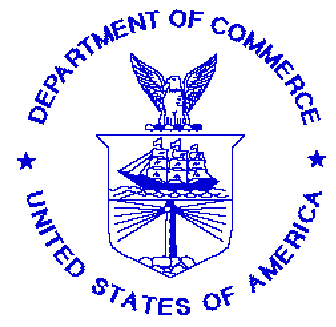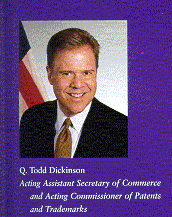Patents and trademarks are now inextricably linked to our national, as well as global economic well-being. Patents have assumed ever-increasing importance in stimulating investment in high-technology industries and in creating jobs for millions all around the globe. Trademarks have facilitated business development by offering protection from unfair competition while helping consumers select products and services that satisfy their needs.
Truly, it can be said that the United States Patent and Trademark Office touches our lives at work, at home and at play-everywhere in today's world.

U.S. DEPARTMENT OF COMMERCE
William M. Daley
Secretary
U.S. PATENT AND TRADEMARK OFFICE
Q. Todd Dickinson
Acting Assistant Secretary of Commerce and
Acting Commissioner of Patents and Trademarks
 Message from the Acting Commissioner
Message from the Acting Commissioner
These are exciting times at the U.S. Patent and Trademark Office. In FY 1998 we received unprecedented numbers of patent and trademark applications, hired over a thousand new employees, and moved our proposal for consolidated, modern facilities closer to reality. Having practiced intellectual property law for more than twenty years prior to joining the PTO in December 1997, and being confirmed as Deputy Commissioner in June 1998, I believe strongly in the importance of intellectual property to the economy of both the United States and the world. I am convinced that customer service must be our chief goal-by being more accessible to our customers, by improving the quality and quantity of our work, by attracting and keeping the best people, and by continuing to improve our business execution.
As a bureau of the U.S. Department of Commerce, the PTO is committed to the mission of job creation, sustainable economic growth, and better living standards for all Americans, and our task is to promote intellectual property rights systems as a means of protecting our economic prosperity. Our mission is to administer the laws relevant to granting patents and registering trademarks, and to advise the Secretary of Commerce and the President on intellectual property protection and the trade-related aspects of intellectual property. To ensure that we keep working toward our strategic goals, each business area developed a single performance goal, together with a series of business goals and performance measures to test how well each business area is progressing toward achieving its goal. In FY 1998, we did very well toward reaching these goals.
The past year
The PTO attained a number of important milestones in FY 1998. The number of patent and trademark applications we received grew 6 percent to 489,050, and we received our first trademark applications over the Internet. We hired 1,015 employees, 829 of them new patent or trademark examiners. Employees continued to improve their skills through training opportunities, and 760 employees continued their education through PTO University, with 86 receiving degrees. Since our success greatly depends on automation, we have continued the effort to move to a fully electronic patent and trademark system, both for our employees and for our customers, including modernizing our fee collection processes and establishing a system to accept credit card payments over the Internet for trademark applications.
1999 and beyond
In recognition of our value to the national economy, Vice President Gore has designated the PTO a High-Impact Agency, and we made seven commitments to the Vice President to further improve our work:
- Reduce processing time to patent original inventions to 12 months by 2003;
- Start electronic processing of patent applications in 2003;
- Reduce trademark processing time to three months to first action and offer electronic filing capabilities to our customers;
- Work with the World Intellectual Property Organization to achieve the electronic filing of Patent Cooperation Treaty applications;
- Enable customers to use the Internet to determine the status of patent and trademark applications, place orders and receive products, and access patent and trademark data;
- Establish a cost-aligned fee schedule that encourages filings;
- Offer employees more work-at-home opportunities and training programs.
These seven commitments parallel goals we have set for our internal business areas, and by fulfilling these commitments, we will make progress toward our own goals. In addition, I am taking a personal interest in two areas where I think we can make improvements to benefit the PTO, its customers, and the intellectual property system: quality management and outreach to independent inventors.
This annual review discusses our accomplishments in FY 1998 and our goals for the future. Building on the strong foundation of leadership and results established under the tenure of Commissioner Bruce A. Lehman, I am convinced that the PTO has what it takes to be a truly successful agency. What makes me confident is the enthusiasm of our customers and our employees for our plans for the future.
Sincerely,

Q. Todd Dickinson
Acting Assistant Secretary of Commerce and
Acting Commissioner of Patents and Trademarks
Management Discussion and Analysis
We continued on our path to obtaining modern facilities. A business case analysis of space facilities management prepared by a certified public accounting firm concluded that by consolidating our buildings we could save $72 million over the cost of another term lease at the PTO's present location. This analysis was further reviewed and endorsed by the Office of the Secretary of Commerce and the Office of Management and Budget.
Our search for a developer is also making progress. In October 1997, four groups submitted Phase II proposals to the General Services Administration. One subsequently withdrew; in September the GSA completed discussions with the three remaining groups. The next step is the award of the lease, expected early next year.
Congress passed H.R. 4328 on October 21, granting the PTO an appropriation of $745 million for FY 1999, an increase of about 8percent more than the previous year. Congress rescinded $71 million from balances of prior year fees as a deficit reduction measure.
The patent fee surcharge imposed by the Omnibus Budget Reconciliation Act of 1990 (OBRA) finally expired at the end of FY 1998. With the expiration of the surcharge, patent fees would have reverted to their pre-OBRA level, a level too low to fund our operations. To avoid this, Congress enacted a series of spending bills containing a provision that maintained patent fee amounts at FY 1998 levels as a temporary measure. On November 10, the President signed into law H.R. 3723, the United States Patent and Trademark Office Reauthorization Act, Fiscal Year 1999 (Pub.L 105-358), reducing many patent fees by a modest amount. As a consequence, we expect the PTO's patent fee collections in FY 1999 to be reduced by about $54 million.
We once again received an unqualified opinion from the Department of Commerce's Inspector General on our FY 1998 financial statements, reaffirming our financial management as an area of strength. We modernized our fee collection processes, establishing a system to accept credit cards via the Internet for trademark applications.
Because automation is crucial to our success, we are quite concerned with potential threats to our automated systems from the century date change (the Y2K problem). Were we to take no action, the PTO would shut down on January 1, 2000. To avoid this, we have adopted a systematic, incremental approach to resolving the Y2K problem, involving replacement of legacy systems, and testing and validating new systems.
We have made substantial progress preparing for the Year 2000. As of November 1998, we had completed 66 percent of the work on our 35 mission-critical systems. Of those, 23 are fully Y2K compliant; we will repair or replace the others by the end of June 1999, with most finished by March. Those legacy systems which may not be replaced in time are being modified to ensure they are Y2K compliant. By the end of FY 1998, we had budgeted over $7.2 million directly to resolving Y2K issues. We expect to spend $3.4 million more over the next two years to coordinate and monitor replacement and repair work and validate Y2K compliance, and an additional $16.4 million in FY 1999 to replace legacy systems and major components. Our contingency plans include establishing manual procedures to protect us against the failure of one or more mission-critical systems, and promptly prioritizing and resolving any failures that do occur.
With our compliance work nearing completion, the most likely worst-case scenarios involve systems shared with other agencies. The Federal Financial System (FFS), the PTO's core financial system, is provided to the PTO under a cross-servicing agreement between the Department of Interior's U. S. Geological Survey and the PTO. The Department of Interior is working to make the FFS mainframe Y2K-compliant as well, and we are monitoring their progress. Should they not be ready, we have established contingency plans to rely on manual procedures until the system is operating again.
The National Finance Center's Pay/Personnel System, which provides the PTO's pay and personnel management services, is provided to the PTO under a cross-servicing agreement between the Department of Agriculture and the PTO. The PTO is monitoring the progress of the Department of Agriculture's Pay/Personnel System Y2K compliance work. We do not have a contingency plan in case they are not ready, as the PTO is not permitted to maintain its own payroll system.
With the exception of these external systems, we are confident that work on all mission-critical systems will be complete well in advance of January 1, 2000. Problems in other systems are likely, but we have contingency plans for resolving them quickly, and none should significantly affect the PTO's mission.
Our people, their needs, and their futures are crucial to our success. The skills, knowledge, and abilities of our employees are among our most valuable assets. To provide customers with the highest level of service, we must have personnel of the highest quality, and they must be properly trained. To attract people with the right training and scientific backgrounds-people that are also in high demand in other industries-we must become an employer of choice. Also, while our need for staff to perform manual tasks is declining, our need for technically proficient support staff is rising.
We are working with our employees to transform both the PTO and its workforce to meet these needs. We are establishing a series of innovative employee programs to familiarize the clerical, technical, and administrative workforce with more automated business methods. We have set high recruitment and retention goals for FY 1999, when we will recruit more than 1,000 additional staff. We are also working to obtain demonstration authority to implement a pilot for an alternative compensation system. With these changes, the PTO is now and will become an even more exciting and rewarding place to work for the dedicated employee.

